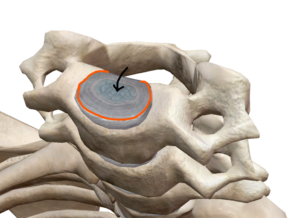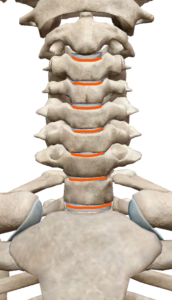Neck Pain: Common Causes
Structure and Function of Intervertebral Discs
The intervertebral discs have a strong outer layer of fibers and a gel-like inner core made of water, proteins, sugars, and collagen. These structures are typically robust, designed to withstand the stresses placed on the neck. However, as we age, the proteins and collagen within these discs break down, which leads to a loss of structural support for the neck.
How Aging Affects Disc Health
As the intervertebral discs weaken over time, the muscles around the joints begin working overtime to stabilize the spinal column. This overcompensation can lead to stiff neck muscles, and in some cases, the body’s protective mechanism may cause tightness to guard the joints against further damage.
Disc Herniation and Nerve Compression
When the annular fibers of the disc become damaged, the disc may bulge or herniate, pressing on nearby nerves. This pressure on the nerves can cause symptoms such as pain, pins and needles, numbness, or weakness in the hands, shoulders, or upper back. Additionally, the body triggers an immune response to address the injury, causing inflammation and further discomfort.
Early Symptoms and Disc Damage
It’s important to note that early disc damage may not immediately cause symptoms. This is because only the outermost fibers of the disc contain nerve endings. As a result, disc issues are often not felt until they progress. Disc-related problems are quite common, especially as people age. Symptoms may include numbness, tingling down the arm or back, or centralized pain near the spine among may other presentations.
Common Locations for Disc Herniation
Most disc herniations in the neck occur at the C5-6 or C6-7 levels. These issues typically develop gradually due to age-related changes or repetitive stress, such as smoking, poor posture, lack of adequate exercise, or excessive smartphone use. Reduced neck curvature is another factor that can increase the risk of developing disc problems.
Preventing and Managing Disc-Related Neck Pain
By understanding the common causes of disc herniation and degeneration, you can take proactive steps to reduce the risk of injury. Practices such as avoiding excessive strain on the neck, and strengthening the muscles around the cervical spine can help prevent disc-related pain.
References
- Healy JF, Healy BB, Wong WH, Olson EM. Cervical and lumbar MRI in asymptomatic older male lifelong athletes: frequency of degenerative findings. Journal of computer assisted tomography. 1996 Jan 1;20(1):107-12. Link
- Constantoyannis C, Konstantinou D, Kourtopoulos H, Papadakis N. Intermittent cervical traction for cervical radiculopathy caused by large-volume herniated disks. Journal of manipulative and physiological therapeutics. 2002 Mar 1;25(3):188-92. Link
- Kramer J. Intervertebral Disk Diseases. Causes, Diagnosis, Treatment and Prophylaxis. George Thieme Verlag, Stuttgart Year Book, Medical Publishers Inc; 1981.


